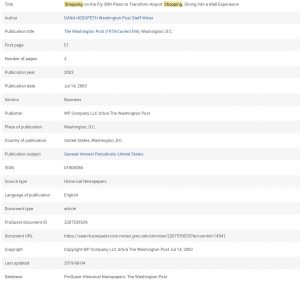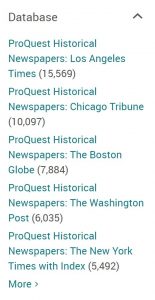Overview: This is a brief review of ProQuest’s Historical Newspapers database. The following questions related to a general search titled “shopping AND marketplace”. This search originated from the previous module relating to database analysis and metadata introduction. Here is a link to the search page. It displays the raw results presented without any metadata specifics attached.
- What features of the digital objects does the metadata describe?
- I have attached a picture of the tool bar that displays the metadata for the objects. In this case, the objects are newspaper articles that have been digitized.

-
- Moreover, this tool bar shows: Date Range, Document Type, Publication Title, and Database.
- Date range refers to the date of publications. One is able to narrow in on a specific object by year, month, week, and day specifications. This database also shows the metadata for the number of objects in each year, month, week, and day. The bar graph is representational to the number of published articles.
- The document type refers to the kind of article that was published: advertisements, classifieds, article, or general information.
- The publication type refers to what major publisher printed the article. One is able to narrow a search by choosing organization like the New York Times, Los Angeles Times, The Chicago Tribune, and much more. However, this type displays the newspapers grouped by years. Therefore if one wants all of the New York Times articles relating to “marketplace”, then one is better off using the “database” search tab.
- The “database” search tab in the tool bar refers to the groupings of the major newspapers. Meaning, just like publication type refers to the publisher, so too does “database”; however, narrowing down according to database provides and index of resources. And, most importantly, the “database” search tab groups all papers by publisher regardless of year.
- Lastly, the methodology of this database is text mining. It uses an OCR to mine for specific searches such as “shopping” and “marketplace”. However, this could give way to difficulty as this algorithm provides many results. One would have to use a proximity limiter, a NEAR search type, in order to narrow down articles that pertain to only shopping and marketplace.
- Moreover, this tool bar shows: Date Range, Document Type, Publication Title, and Database.
- What features does it not describe?
- When one selects a news article, one is able to view all relevant metadata pertain to that object.

-
- However, this database dose not allow you to search the following:
- Authorship. One is not able to search for specific authors unless one does a new “basic” or “advanced” search.
- Moreover, searching by author allows the researcher to follow the creator’s argument. Simply, when working with newspapers, narrowing in on a specific author allows the researcher to follow the literary arguments of that author throughout the course of the journalist’s career.
- Author specific metadata also provides information on collaboration works, and if and how often that author collaborated with other journalists.
- Authorship. One is not able to search for specific authors unless one does a new “basic” or “advanced” search.
- However, this database dose not allow you to search the following:
- What questions does the metadata allow you to ask?
- Regarding publication date, the metadata is quantified, allowing the researcher to visually see how many articles were published in a given year, month, week, and day. This quantification is done visually via a bar graph. One can also move the mouse cursor over the data and a small information box will appear.
- Also, with the “database” search tab, one is able to see how many articles there are broken down according to publisher. For example, this search yielded 5,492 articles from The New York Times between 1870-2015.

- What questions does it not allow you to ask?
- Ownership of newspaper is not a metadata category mentioned or calculated in this database. When working with newspapers as primary sources, it is very helpful to track the change in ownership. Understanding who owned the paper and when can help shed light as to what the paper was publishing the articles that it printed.
- Tracking ownership would also allow a researcher to easily understand the variety and diversity of newspaper owners. However, when looking into the histories of these major newspaper, one is guaranteed to find ownership in the hands of wealthy male elites.
- Furthermore, one is not able to search by author. It would be interesting to track the quantity of articles written by each author. Does this type of quantification would give a better understanding as to the journalists forte. This type of metadata could also track how often an author’s story is to make the front page. If one journalist continually makes the front page, then that could lend itself to an investigation of the company’s internal dynamics.